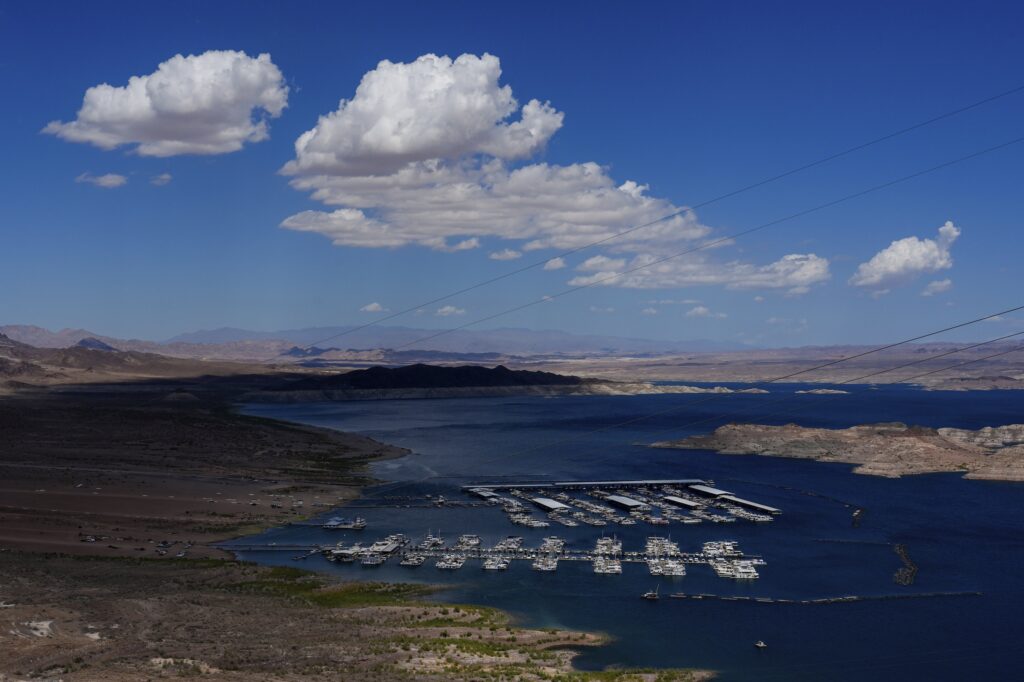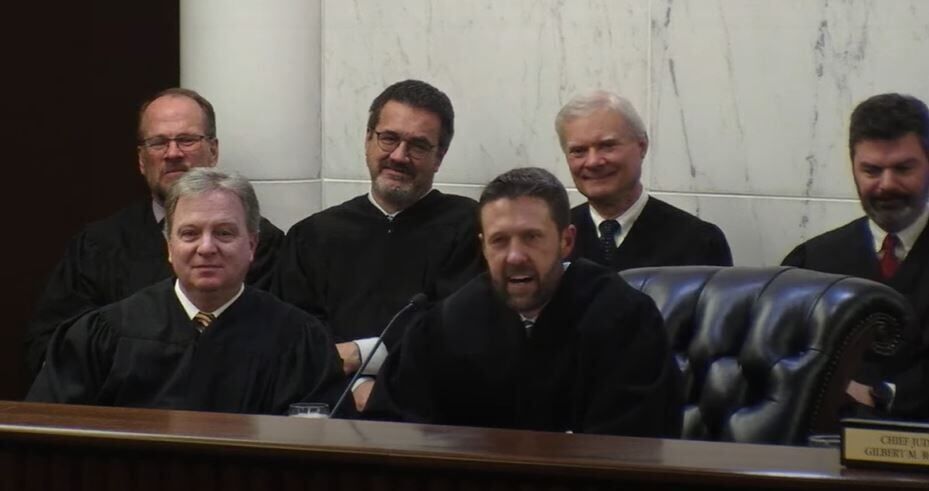UPDATE: Hickenlooper swigs river water as slow recovery from EPA spill begins
AUG. 13 UPDATE: There may be nothing that Colorado Gov. John Hickenlooper won’t drink to prove a point, including the previously neon-orange water from the Animas River.
A day before EPA administrator Gina McCarthy announced that toxicology tests show the water quality has returned to pre-contamination levels, Hickenlooper dipped his water bottle into the Animas and took several swigs in response to a request from the Durango Herald, which filmed the event.
“Am I willing to go out there and demonstrate that we’re back to normal?” Hickenlooper told the Herald beforehand. “Certainly. I’m happy to do that. I’m dead serious.”
The Democrat governor, famous for drinking fracking fluid to prove its safety, added a tablet of iodine to his bottle to kill giardia and E. coli germs on the advice of Dr. Larry Wolk, Colorado’s chief medical officer.
“Don’t ever drink river water [without iodine], but it’s perfectly fine for rafting,” Hickenlooper said afterward.
Hickenlooper’s gesture was intended as a boost to Durango’s watercraft industry, which is expected to reopen soon even though the environmental crisis surrounding the EPA’s accidental uncorking of 3 million gallons of wastewater from the Gold King Mine is far from over.
Attorney General Cynthia Coffman agreed Wednesday that the last few days have brought promising signs, including back-to-normal water-testing results, low fish kills and normal insect life, but warned that damage to the region from the heavy-metal release may not show up for months or even years.
She met Wednesday with the attorneys general from New Mexico and Utah in what could be a precursor to a multi-state lawsuit against the EPA.
“This is not the end of the story. This is the beginning,” she said at a joint press conference in Durango filmed by Denver’s 7News.
“I caution folks who are ready to celebrate — certainly Durango is open for business. Silverton is,” Coffman said. “We want people to come to Colorado and see our natural beauty, but at the same time, we have to protect what is ours.”
Still looming are questions surrounding what exactly is in the water — the EPA continues to dribble out test results from water samples — as well as how the agency plans to handle the clean up and claims from local businesses and others hurt by the river’s shutdown shortly after the Aug. 5 accident.
McCarthy, who said Tuesday in Washington, D.C., that she was “deeply sorry” about the spill, toured the Animas River Wednesday and held a brief press conference at the EPA’s unified area command in Durango.
She also announced she has shut down all agency mining clean-up operations pending a review in order to avoid a repeat of the blowout.
“No agency could be more upset about the incident happening, and more dedicated in doing our job to get this right,” she said. “We couldn’t be more sorry. Our mission is to protect human health and the environment. We will hold ourselves to a higher standard than anyone else.”
The orange plume has exited Colorado, although orange sediment remains on the river bottom, banks and rocks. Drainage continues to exit the Gold King Mine at a rate of 500 to 700 gallons per minute, but EPA officials are now capturing the outflow in settling ponds and treating it.
“[T]hose metals settle into the sediment along the river, and they are upset by every rainstorm, by rafters, by a snow melt,” said Coffman. “Every time the water is churned up, the sediment is churned up.
“And so we have to be vigilant as attorneys general, as the lawyers from the state, as protectors of the environment, to be sure that the assurances that we receive today from the Environmental Protection Agency are the same in two years and five years and even 10 years, when we discover what the damage to the environment actually is,” Coffman said.
Republican Sen. Cory Gardner has called for congressional oversight hearings into the spill in order “to examine EPA’s insufficient response and to ensure that the EPA is held to the same recovery standards as the private sector.”
The EPA has come under intense criticism both for the spill and for waiting 24 hours before notifying anyone. EPA Region 8 administrator Shaun McGrath said those on the ground underestimated the extent of the blowout.
Gardner, Sen. Michael Bennet and Rep. Scott Tipton were joined by New Mexico lawmakers in a letter Tuesday to President Obama calling for “all appropriate federal resources on the tragic Gold King Mine spill that occurred last week in Southwest Colorado.”
The spill moved from the Animas River to the San Juan River in New Mexico, rendering unsafe drinking and irrigation water supplies for the Navajo Nation and other communities along the river’s path. The orange release, now diluted and barely visible, is next expected to enter Utah and Lake Powell.
Water supplies from the Animas, one of two sources for drinking water in Durango, have been turned off since last week. Hickenlooper declared a state of emergency Sunday for the region, while the Southern Ute tribe issued a proclamation Monday declaring a state of disaster at the reservation near Durango.
Southern Ute chairman Clement J. Frost said that the EPA and the tribe were providing drinking water for those dependent on the Animas watershed.
“The environmental and economic consequences of this disaster will not be known for some time, but the Tribe is doing everything in its power to respond to this terrible situation,” Frost said in a statement.
Meanwhile, Hickenlooper has apparently lived to tell the tale after ingesting water that just a few days earlier looked more like mustard than Dasani.
“It didn’t taste bad at all,” he said.
————————————-
The Environmental Protection Agency’s accidental spill of acidic wastewater last week turned the Animas River into a toxic brew, but to Ellen Roberts, the polluted waterway running through Durango feels more like a sick friend.
The Republican state senator spent the last few days alongside the ailing river, first warding away those who tried to raft or swim in it, then watching it change to a mustardy orange, and, finally, just spending time with it.
“There are people who live here, they were coming to the river all day yesterday and last night just to see how it was doing,” said Roberts. “People are disturbed, they’re angry, they’re concerned, but they’re really sad. Because this is an integral part of our community.”
“At lunch time, I went down and ate my lunch down by the river,” she added. “It doesn’t smell bad. It just looks bad. It looks really bad.”
EPA Region 8 administrator Shaun McGrath took responsibility for the accident in a Saturday press call, insisting that the agency was to blame and not the independent contractors working alongside agency employees when the orange goo was unleashed into Cement Creek from the Gold King Mine.
He also said he did not know the name of the general contractor hired by the EPA.
“Although I don’t have the name yet, I do want to be clear here: our folks, EPA employees, were on the site and directing the contractor work, and EPA takes responsibility for what happened up there,” McGrath said. “I just want to be clear on that point.”
There were four workers present Wednesday morning when they accidentally released 1 million gallons of wastewater at about 10:40 a.m. Wednesday from the abandoned, inactive mine near Silverton. Even so, the EPA did not contact local, state or regional officials for another day.
On Sunday, the EPA revised upward its estimate from 1 to 3 million gallons.
“When the event happened Wednesday, the people on the ground misinterpreted, misread the severity of the impact,” said McGrath. “We believed in the first day that it was going to be a smaller discharge, it was going to be limited to Cement Creek, and, as a result, our response was designed to the impacts we were anticipating.”
“We misjudged. And this is something that I’m owning up to,” McGrath said.
As a result, his office did not contact Region 6 administrator Ron Curry, who oversees New Mexico, for 24 hours after the spill.
“[A]s a result, the message to my colleague Ron Curry was delayed, it was a day delayed, and we do apologize for that,” said McGrath. “On the other side of it, though, as soon as we understood the significance of release, we have ramped up accordingly and have really done the outreach to states, to tribes, to the local governments, to try to be as transparent with information, to get information out as quickly as we can. So that situation has changed.”
He said the flow of wastewater from the mine has diminished from 730 gallons per minute to 538 gallons per minute as of Saturday afternoon. The agency has also constructed settling ponds to catch the wastewater as it leaves the breach and treat it with chemicals before it reaches the Animas River.
Drinking water supplies have been cut off from Durango to New Mexico as the EPA works to determine what contaminants and heavy metals are in the muck, but McGrath said the impact to the region is likely to endure even after the water is deemed safe to drink and the river is reopened for recreation.
“I can’t give you a firm number of days or weeks that it’s going to take. I don’t know,” McGrath said.
“This is going to be a long-term impact. The sediment, the metals that are in that sediment are going to settle out to the stream bottom,” he said. “As we have storm surges, as we have flooding events, that sediment can and likely will get kicked back up into the water, and we’re going to have to do ongoing monitoring and then potential closures in the future as well.”
Colorado lawmakers issued statements expressing their concern and pledging their support for the cleanup effort, but Republicans also took jabs at the EPA for failing to meet the same high standards of care it requires from private companies.
Republican Rep. Scott Tipton said, “There is widespread frustration with the EPA’s initial response and the lack of information coming out of the agency — the poor communication is unacceptable.”
“If a mining operator or other private business caused the spill to occur, the EPA would be all over them,” Tipton said. “The EPA admits fault, and as such must be accountable and held to the same standard. In the coming days my staff and I will be working to get a full picture of what happened, as well as an answer to a question on many people’s minds: what resources and funds will the EPA dedicate to clean up the site and provide restitution for damages?”
In New Mexico, where drinking water supplies are being turned off as the wastewater crosses the state line, Republican Gov. Susana Martinez blasted the EPA for its lack of notice, saying that she had learned of the spill a day after it occured from the Southern Ute Tribe.
“Imagine what would happen if a private company caused this waste spill,” said Martinez in a statement.
“This was caused by the EPA and the EPA should demand the same of itself as it would of a private business responsible for such a spill, particularly when it comes to making information available to the public and state and local officials,” she said.
There was a more muted response from Democratic Gov. John Hickenlooper, who sent out a Tweet on Friday saying, “We are working hard to support the @EPA in the Gold King Mine release cleanup. Public safety and environment remain priority for Colorado!”
For Durango, the acidic spill could not come at a worse time, shutting down the recreational watercraft and fishing companies that making their living along the Animas River.
“This is still the height of our tourist season,” said Roberts. “In the summertime, what we do is we get in the river, whether it’s for fishing, tubing — kids and adults. We’ve got our rafting companies. Someone had told the rafting companies, so, by mid-afternoon, none of them were operating in the water.”
Not everyone got word in time. At a packed public meeting Friday in Durango, Roberts said some farmers said “they actually did have some of that water flow from the river into their ditches.”
Farmers and ranchers want to know when it will be safe to use the water again for irrigation and livestock. Firefighters want to know if using the contaminated river water to douse fires will gum up their equipment or harm their health.
“One woman stood up and said, ‘I’m a restaurant owner. I’m trying to figure out what’s going on here. I’m trying to figure out how to serve my customers,’” Roberts said.
More public meetings are expected as lab tests on water samples reveal more about the contaminants, including whether significant levels of metals such as arsenic and mercury made it into the river.
“I do appreciate that the EPA sent regional administrator here and he opened himself up to the questions of the community and elected officials,” Roberts said. “I appreciate them taking responsibility for what they did. Now, where we really need to focus is, how do we deal with it?”












